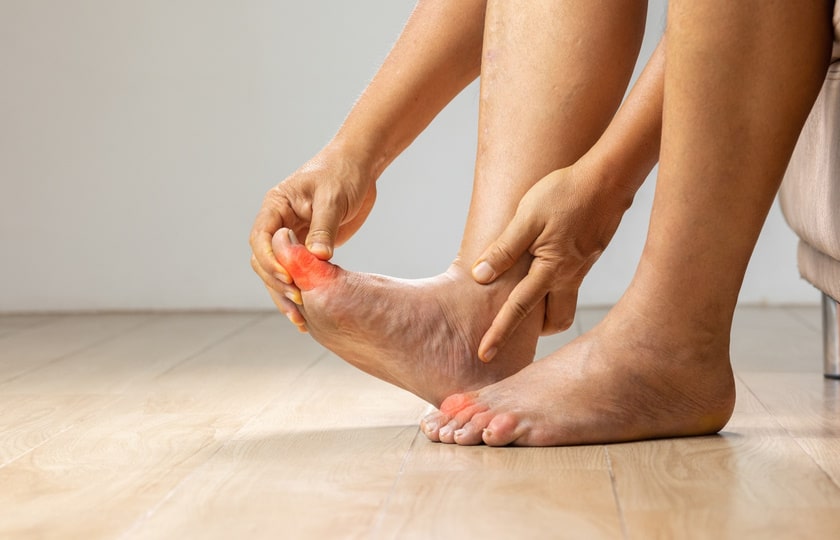
Edema, commonly known as swelling, is a condition marked by an accumulation of fluid in the tissues of the body. This build-up can lead to noticeable swelling, primarily affecting the extremities such as hands, arms, feet, ankles, and legs. However, it’s not limited to these areas and can occur anywhere in the body.
Understanding the Fluid Balance in the Body
The human body maintains a delicate balance of fluid in tissues, which is essential for normal functioning. This fluid balance is regulated by a complex interplay between the blood vessels, the lymphatic system, and the kidneys. When this balance is disrupted, it can result in an excessive accumulation of fluid, leading to edema.
Types of Fluid Accumulation
Interstitial Fluid Accumulation: Most commonly, edema is caused by excess fluid being trapped in the body’s interstitial spaces, the areas between cells.
Organ-Specific Swelling: In some cases, edema can affect specific organs, such as the lungs in pulmonary edema or the brain in cerebral edema.
The most apparent sign of edema is swelling or puffiness in the affected area. Other visible indications include:
- Stretched or shiny skin over the swollen area.
- A lingering dimple or indentation after pressing on the swollen area, is known as pitting edema.
- In non-pitting edema, the area may be swollen but does not retain an indentation when pressed.
Sensations Associated with Edema:
Apart from visible changes, edema can also be accompanied by other sensations, including:
- A feeling of heaviness or tightness in the affected limbs.
- Pain or discomfort in the swollen area.
- Restricted range of motion or stiffness in the joints affected by swelling.
Common Misconceptions
It’s important to differentiate edema from temporary swelling that can occur due to factors like a minor injury, prolonged standing or sitting, or dietary choices. Unlike these temporary conditions, edema is often indicative of an underlying health issue and can persist or recur until the underlying cause is addressed. Often, the swelling itself isn’t the problem, but a sign of an underlying problem.
The Importance of Medical Attention
While mild edema can sometimes be managed with lifestyle changes and self-care, persistent or severe swelling warrants medical attention. This is particularly crucial because edema can be a symptom of various underlying health problems, some of which require prompt treatment.
What are the Different Types of Edema?
Edema can manifest in various forms, each with its specific causes and characteristics. Understanding these types is crucial for identifying the appropriate treatment strategies.
- Lymphedema
Lymphedema occurs due to a blockage in the lymphatic system, preventing the drainage of lymph fluid. This results in swelling, usually in the arms or legs.
Causes: It can be caused by lymph node removal (commonly in cancer treatments), infection, or congenital conditions affecting the lymphatic system. Another common cause for lymphatic edema is previous infections ( bacterial or even filarial)
- Deep Vein Thrombosis (DVT) and Blood Clots
DVT is a blood clot in a deep vein, often in the leg, leading to swelling, pain, and redness.
Causes: Causes include prolonged immobility, certain medications, and medical conditions that affect blood clotting.
- Pulmonary edema
This type of edema involves fluid accumulation in the lungs, making breathing difficult.
Causes: Often related to heart problems, such as congestive heart failure, but can also be caused by severe infections, trauma, or exposure to certain toxins.
- Cerebral Edema
Swelling in the brain is often a response to injury, infection, or other conditions like high altitude sickness.
Causes: Traumatic brain injury, stroke, infections, tumours, and certain medical treatments.
- Macular Edema
This affects the macula in the retina of the eye, leading to vision issues.
Causes: Often associated with diabetes (diabetic retinopathy), eye surgery, or macular degeneration.
- Peripheral Edema
Manifests as swelling in the lower extremities (legs, ankles, and feet) or arms.
Causes: Can be due to prolonged standing or sitting, medication side effects, pregnancy, heart failure, kidney or liver disease.
- Pitting Edema
Characterized by a dimple or pit forming when the swollen area is pressed. It’s not a separate type but rather a characteristic that can occur in various types of edema. The depth and duration of the pit can help determine the severity of the edema.
- Periorbital Edema
Involves swelling around the eyes, often noticeable upon waking up.
Causes: Causes range from allergies and infections to more serious conditions like orbital cellulitis or Graves’ disease.
Understanding the Specific Types of edema
Each type of edema has its unique set of symptoms and underlying causes. For instance, the swelling in the legs observed in peripheral edema may differ in sensation and appearance from the swelling in arms seen in lymphedema. Similarly, the systemic implications of pulmonary edema are distinct from the localized effects of macular edema on the eye.
Recognising these differences is vital for effective treatment and management. For example, while lymphedema may require specialized physical therapy and compression garments, pulmonary edema might necessitate immediate medical intervention to address the underlying cardiac issues.
The Common Symptoms Associated with Edema
Edema, or swelling, can present with various symptoms depending on its type and the underlying cause. Recognizing these symptoms is crucial for early diagnosis and treatment. Here are the common symptoms associated with different types of edema:
General Symptoms
Swelling or Puffiness: The most obvious sign of edema is an increase in size or puffiness in the affected area, which can feel soft to the touch.
Stretched or Shiny Skin: The skin over the swollen area may appear stretched, shiny, or glossy.
Pain or Discomfort: The affected area might be tender or painful, especially when pressed.
Stiffness or Decreased Mobility: In cases where joints are affected, there may be stiffness or a decreased range of motion.
Specific Symptoms by Type
Lymphedema: Besides swelling, there’s often a feeling of heaviness or tightness, and the skin may become harder or thicker over time.
Deep Vein Thrombosis: This can cause localized swelling, warmth, and redness, often in one leg. It might also be accompanied by pain or tenderness, especially when standing or walking.
Pulmonary Edema: Symptoms include shortness of breath, difficulty breathing, especially when lying down, and sometimes a cough that produces frothy sputum.
Cerebral Edema: This might present with headache, confusion, dizziness, or seizures, depending on the severity and location of the swelling in the brain.
Macular Edema: Vision changes, such as blurriness or seeing wavy lines, are common symptoms.
Peripheral Edema: Swelling in the lower extremities is often accompanied by a feeling of heaviness, and the skin may retain a dimple after being pressed (pitting edema).
Periorbital Edema: This includes puffiness or swelling around the eyes, and in some cases, it may cause difficulty in opening or closing the eyes completely.
Additional Considerations
While these symptoms are typically associated with physical manifestations of edema, it’s important to consider the underlying causes. For example, swelling in the legs (peripheral edema) could be a sign of heart failure, liver disease, or chronic venous insufficiency. Similarly, pulmonary edema might indicate a more serious underlying heart condition.
When to Seek Medical Attention
It’s advisable to consult a best vascular Surgeon in Vadodara if you experience unexplained or persistent swelling, especially if it’s accompanied by other symptoms like shortness of breath, chest pain, or changes in consciousness. Early diagnosis and treatment are key to managing edema effectively.
The Causes of Edema and its Underlying Conditions
Edema can result from a variety of causes, ranging from relatively benign to serious medical conditions. Common causes include prolonged sitting or standing, which can lead to fluid accumulation in the legs and dietary factors such as excessive salt intake. Medical conditions that can cause edema include congestive heart failure, where the heart is unable to pump blood efficiently, leading to fluid buildup; kidney disease, which affects fluid and salt balance; and liver disease, which can alter the production of proteins needed to maintain blood volume. Hormonal changes during pregnancy can also cause edema. In some cases, medications like high blood pressure drugs, nonsteroidal anti-inflammatory drugs (NSAIDs), and certain diabetes medications can induce edema as a side effect.
How is Edema Treated?
Treatment for edema depends on the underlying cause. When edema results from lifestyle factors, such as being overweight or sedentary, lifestyle changes are the first line of treatment. These may include increasing physical activity and reducing salt intake. In cases where edema is due to a medical condition, treating that condition is the priority. This could involve using diuretics to reduce fluid retention in cases of heart or kidney disease, adjusting medications if edema is a side effect, or providing support stockings for venous insufficiency.
For localized causes of edema, stockings, massage and the use of Intermittent pneumatic compression pumps ( eg Lymphapress) can be very helpful.
In severe or resistant cases, more advanced treatments, like surgery, may be required, especially for types like lymphedema.
Effective Ways to Reduce Leg Swelling: Causes and Treatment Options
When to Seek Help for Edema?
It’s important to seek medical help for edema when it is sudden, severe, or accompanied by other symptoms like chest pain, difficulty breathing, or abdominal pain, as these could indicate serious underlying conditions such as heart failure or deep vein thrombosis. Persistent edema, even without other symptoms, warrants a medical evaluation to determine the underlying cause. Additionally, if edema is affecting your quality of life, limiting mobility, or causing discomfort, consulting a healthcare provider can provide relief and prevent complications.
Self-Care Tips by Dr. Sumit Kapadia
Dr. Sumit Kapadia emphasizes the importance of self-care in managing mild cases of edema. Key strategies include reducing salt intake, as salt can cause the body to retain water; engaging in regular physical activity to improve circulation; elevating the legs whenever possible, especially if the swelling is in the lower limbs; avoiding sitting or standing in one position for too long; ensuring regular movement during long trips; avoiding extreme temperatures; and dressing warmly in cold weather to help circulation. These measures can help alleviate the symptoms of edema and improve overall vascular health.
How Soon After Treatment Will I Feel Better?
The time it takes to feel better after starting treatment for edema varies depending on the underlying cause and the type of treatment. If edema is due to a reversible cause, such as medication side effects or dietary factors, improvement can be quite rapid upon addressing these factors. For edema resulting from chronic conditions like heart or kidney disease, it may take longer to see improvement as the treatment focuses on managing the condition. The response to treatment also depends on individual factors such as overall health, age, and the severity of the edema.
Understanding the types of edema, their symptoms, causes, and available treatments is crucial for effective management. For personalized care and expert treatment in Vadodara, contact Vascular and endovascular Surgeon Dr Sumit Kapadia at Aadicura Superspeciality Hospital, patients receive not just treatment but a roadmap to better guidance for treatment of edema. For consultations, reach out to Dr Sumit Kapadia’s appointment number or send a “Hi” message to +91 9904114443 on WhatsApp (Dr Sumit Kapadia’s 24 x 7 Vascular Helpline).

MBBS, MS, MRCS, DNB-Fellow
Dr. Sumit Kapadia
Dr. Sumit Kapadia / MR KAPADIA SUMIT a gold-medalist from Baroda Medical College, obtained his general surgical training and senior residency from SSG Hospital, Vadodara.

MBBS, MS, MRCS, DNB-Fellow
Dr. Sumit Kapadia
Dr. Sumit Kapadia / MR KAPADIA SUMIT a gold-medalist from Baroda Medical College, obtained his general surgical training and senior residency from SSG Hospital, Vadodara.



